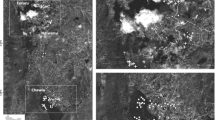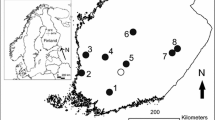Abstract
The tropical and subtropical moist forests of South America have been seen as remarkable for their great wealth of animals and plants and as the world leader in bird diversity. However, a problem is apparently affecting bird populations in these habitats, to the extent that most of the sites that I have studied in the last few years were practically “ornithological deserts”. Censuses conducted in the Amazon rainforest in Ecuador and Bolivia have revealed no more than 15 species and 18 individuals in 1 day. It is evident that this is not a problem of the kind usually induced by humans at a local level, such as deforestation, hunting or pesticide use. The low diversity and activity were observed not only in disturbed habitats, but also in well-preserved national parks and reserves. If it is related to human activities, then this must be more widespread. One such possibility is global warming. For ornithological studies, this is a very severe problem that must be closely examined to see whether it is also a threat to bird survival and if it is related to climate change.
Similar content being viewed by others
References
Amadon D (1973) Birds of the Congo and Amazon forests: a comparison. In: Meggers BJ et al (eds) Tropical forest ecosystems in Africa and South America: a comparative review. Smithsonian Institution Press, Washington, DC, pp 267–277
Blake JG (1992) Temporal variation in point counts of birds in a lowland wet forest in Costa Rica. Condor 94:265–275
Blake JG, Loiselle A (1991) Variation in resource abundance affects capture rates of birds in three lowland habitats in Costa Rica. Auk 108:114–130
Borges SH, Cohn-Haft M, Pereira Carvalhaes AM, Magalli Henriques L, Pacheco JF, Whittaker A (2001) Birds of Jaú National Park, Brazilian Amazon: species check-list, biogeography and conservation. Ornitol Neotrop 12:109–149
Collier M, Banks A, Austin G, Girling T, Hearn R, Musgrove A (2005) The wetland bird survey 2003/04 wildfowl and wader counts. British Trust for Ornithology Wildfowl & Wetlands Trust, Royal Society for the Protection of Birds & Joint Nature Conservation Committee
Dixon JR (1979) Origin and distribution of reptiles in lowland tropical rainforests of South America. In: Duellman WW (ed) The South American Herpetofauna: its origin, evolution, and dispersal. Univ Kansas Mus Nat Hist Lawrence, pp 217–239
Emmons LH, Feer F (1997) Neotropical rainforest mammals. University of Chicago Press, Chicago
Haffer J (1974) Avian speciation in tropical South America. Publ. Nuttall Orn. Club, No. 14. Cambridge, Massachusetts
Haffer J (1978) Distribution of Amazon forest birds. Bonn Zool Beirtr 29:38–78
Hilbert DW, Bradford M, Parker T, Westcott DA (2004) Golden bowerbird (Priondura newtonia) habitat in past, present and future climates: predicted extinction of a vertebrate in tropical highlands due to global warming. Biol Conserv 116:367–377
Karr JR (1976) Seasonality, resource abailability, and community diversity in tropical bird communties. Am Nat 110:973–994
Lemoine N, Böhning-Gaese K (2003) Potential impact of global climate change on species richness of long-distance migrants. Conserv Biol 17:577–586
Loiselle BA, Blake JG (1992) Population variation in a tropical bird community. Implications for conservation. Bioscience 42:838–845
Martin TE, Karr JR (1986) Temporal dynamics of Neotropical birds with special reference to frugivores in second-growth woods. Wilson Bull 98:38–60
National Wildlife Federation/American Bird Conservancy (NWF/ABC) (2002) A birdwatcher’s guide to global warming. Available at ABC’s Climate Change and Birds web page
Nores M (1992) Bird speciation in subtropical South America in relation to forest expansion and retraction. Auk 109:346–357
Nores M (1999) An alternative hypothesis for the origin of Amazonian bird diversity. J Biogeogr 24:475–485
Nores M (2000) Species richness in the Amazonian bird fauna from an evolutionary perspective. EMU 100:419–430
Nores M (2004) The implications of Tertiary and Quaternary sea level rise events for avian distribution patterns in the lowlands of northern South America. Glob Ecol Biogeogr 13:149–162
Nores M, Cerana MM, Serra DA (2005) Dispersal of forest birds and trees along the Uruguay River in southern South America. Divers Distrib 11:205–217
O’Neill JP, Pearson DL (1974) Estudio preliminar de las aves de Yarinacocha, Departamento de Loreto, Perú. Publ Mus Hist Nat “Javier Prado” 25:1–13
Parmesan C (2006) Ecological and evolutionary responses to recent climatic change. Ann Rev Ecolog Syst 11:637–669
Parmesan C, Yohe G (2003) A globally coherent fingerprint of climate change impacts across natural systems. Nature 421:37–42
Prance GT (1987) Vegetation. In: Whitmore TC, Prance GT (eds) Biogeography and Quaternary history in tropical America. Clarendon, Oxford, pp 28–45
Richards PW (1952) The tropical rain forest. Cambridge University Press, Cambridge
Robinson S (1983) World record Big Day in southeastern Peru. Birding 15:14–18
Rosenzweig ML (1995) Species diversity in space and time. Cambridge University Press, Cambridge
Saibene CA, Castellino MA, Rey NR, Herrera J, Calo J (1996) Inventario de las aves del Parque Nacional Iguazú (Misiones, Argentina). LOLA Monogr No 9. Buenos Aires
Sanderson FJ, Donald PF, Pain DJ, Burfield IJ, Van Bmmet FPJ (2006) Long term population declines in Afro-Paleartic migrant birds. Biol Conserv 131:93–105
Shoo LP, Williams SE, Hero JM (2005) Climate warming and the rainforest birds of the Australian wet tropics: using abundance data as a sensitive predictor of change in total population size. Biol Conserv 125:335–343
Simpson BB, Haffer J (1978) Speciation patterns in the Amazonian forest biota. Ann Rev Ecolog Syst 9:498–518
Sorenson LG, Goldberg R, Root T, Anderson MG (1998) Potential effect of global warming on waterfowl breeding in the Northern Great Plains. Clim Change 40:343–369
Stattersfield AJ, Crosby MJ, Long AJ, Wege DC (1998) Endemic bird areas of the world. Priorities for biodiversity conservation. BirdLife International, Cambridge
Stotz DF Jr, Bierregaard RO (1989) The birds of the fazendas Porto Alegre, Esteio and Dimona, north of Manaus, Amazonas, Brazil. Rev Bras Biol 49:861–872
Terborgh J, Fitzpatrick WJW, Emmons L (1984) Annotated checklist of bird and mammal species of Cocha Cashu Biological Station, Manu National Park, Peru. Field Zool, Publication No 352. Field Museum of Natural History, Chicago
UNEP (2006) Summary of the second global biodiversity outlook. Note by the Executive Secretary. Conference of the Parties to the Convention on Biological Diversity, 8th Meeting, p 6
Williams SE, Bolitho EE, Fox S (2003) Climate change in Australian tropical rainforests: an impending environmental catastrophe. Proc R Soc Lond 270:1887–1892
Williams JW, Jckson ST, Kutzbach JE (2007) Projected distributions of novel and dissapearing climates by 2100 AD. Proc Natl Acad Sci U S A 103:13116–13120
World Wildlife Fund (2000) Global warming and terrestrial biodiversity decline. Malcolm JR, Markham A. http://www.earthscape.org/r1/wwf04/wwf04.doc
Wormworth J, Mallon K (2007) Bird species and climate change. Climate Risk. http://assets.panda.org/downloads/birdsclimatereportfinal.pdf
Zöckler C, Lysenko I (2000) Water birds on the edge: first circumpolar assessment of climate change on Arctic-breeding water birds. United Nations Environment Programme & World Conservation Monitoring Centre. http://www.unep-wcmc.org/climate/waterbirds/report.pdf
Author information
Authors and Affiliations
Corresponding author
Rights and permissions
About this article
Cite this article
Nores, M. Are bird populations in tropical and subtropical forests of South America affected by climate change?. Climatic Change 97, 543–551 (2009). https://doi.org/10.1007/s10584-009-9613-3
Received:
Accepted:
Published:
Issue Date:
DOI: https://doi.org/10.1007/s10584-009-9613-3




